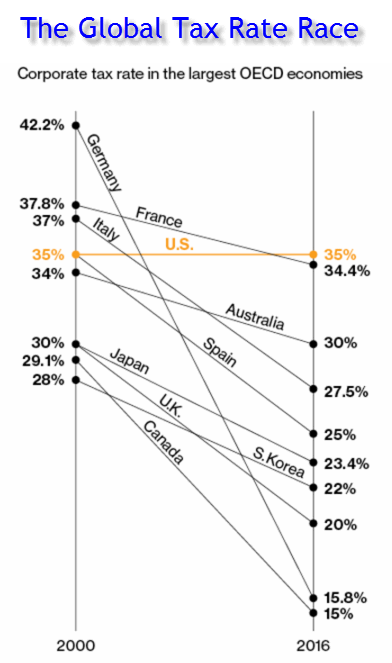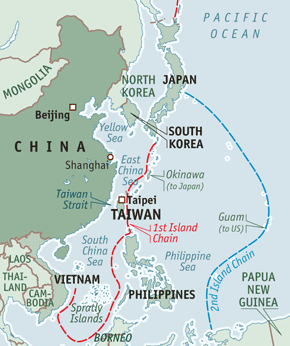Our Tax Code Is a Mess. So Will Be the Battle to Change It
Control of the White House and both chambers of Congress are viewed by Republicans as a once in a generation chance to revamp the tax code. But much as they stumbled on the complexity of reaching consensus to repeal and replace Obamacare, they are sure to find tax reform presents another magnitude of disagreement and difficulty. In what seems to be a rush to get something big on record before his first 100 days elapsed, President Trump demanded a “massive” tax cut “bigger, I believe, than any tax cut ever”. He wants the corporate rate slashed from 35% to 15%, further complicating a dispute already dividing Republican circles. And he wants it to apply even to businesses that pass through profits to their owners, such as his The U.S. tax rate for corporations is the highest among the Group of 20 Nations. There has been a global competition by countries to attract corporations. That has encouraged American corporations either to use accounting legerdemain to park trillions of dollars of profits offshore, or to take the more troubling step of moving to low-tax countries. During the campaign, Trump spoke repeatedly of his intention to lower the corporate tax rate to 15%, but as reality — namely, the needs of financing the U.S. government — set in, he began to speak of cutting the rate to 20%. Now, with the failure to eliminate Obamacare and its costs, the proposed rate spoken of is 28%. That, says Grover Norquist’s Americans for Tax Reform, is apparently the lowest the corporate rate can go while by some unstated alchemy remaining revenue neutral. Revenue neutral makes the rate reduction eligible under Senate rules to be passed under “reconciliation”, which needs only a 51% majority and nixes filibustering by Democrats who traditionally want to soak corporations irrespective of foreign competition. But House Republicans, led by Paul Ryan, still have their sights on a 20% rate for corporations. To fill the crater left by what would be a 43% reduction from today’s 35%, and get to the revenue neutral needed to qualify for reconciliation, they have fastened on their newest great idea, long championed by Texas Republican Kevin Brady, a 20% “border adjusted tax” (or BAT) levied on imported goods. That, they estimate, would bring in what they estimate to be $1.1 trillion over a decade. But if it works, if it discourages imports, wouldn’t the revenue decline in parallel? For U.S. companies that import goods, the tax is meant to offset the cost advantage of producing in low-wage countries. Not only would the goods cost 20% more, but importers would not be allowed to deduct any of their cost as a business expense. The revenue from selling the goods in the U.S. would be deemed all profit — a phantom profit fully taxed. The deal is turned on its head for companies that export goods produced in this country. They would pay no border tax, of course, but neither would they pay any tax whatever on the profit arising from the sale of those goods. The belief is that the favorable tax treatment on exports would render pointless the “inversions” whereby corporations have merged with or been acquired by foreign firms so as legally to move their domicile to a low tax country. uproar
American exporters — such as Boeing, Dow, Caterpillar, the pharmaceuticals — are ecstatic. Importers — such as Walmart, Best Buy, Nike, all retailers — are apoplectic. Corporations that depend on imports, ranging from clothing, to automakers, to refiners would have to raise prices to pay for the import tax and watch sales drop sharply. Economists’ doctrine recited by Republicans says that the BAT would cause the dollar to strengthen — and enough to negate the the 20% tariff on imports, a bit of wizardry that goes unexplained. For exports, that stronger dollar makes U.S. products more expensive — more of a foreign currency is needed to convert to each dollar the exporter charges — and that hurts sales. That’s the reason, say Republican advocates, for charging no tax on the profit of the export and, as an extra incentive to manufacture hear, allow immediate expensing of capital purchases such as machinery, displacing years-long depreciation. Together, the exporter is given a fatter margin for lowering prices to make products less costly in foreign markets. Lost in the argument seems to be whether the corporate tax code would be swept clean of the myriad of loopholes and exceptions that serve to bring down the effective average rate that business pays to more like 18% rather than the 35% posted rate that has spawned so revolutionary a scheme. But that much lower average is poorly distributed. Retailers, for example, with all their sales in the U.S., are exposed to the full rate. upheaval
The BAT amounts to the so-called territorial method of business taxation by another avenue. Most countries tax only domestic activity; they don’t touch whatever a multinational company earns in other countries. That the U.S. reaches its tax tentacles everywhere — not at once, only when overseas loot is brought home — makes basing international companies in the U.S. unattractive. The question of whether this country should adopt the territorial scheme, coupled with the lure of bringing home the accumulated trillions in profit of our multinationals at some deeply discounted tax rate, has been a topic for discussion, but so far no more than that. Along comes the BAT to do the same job. It basically tells an exporter that the U.S. doesn’t care about whatever profits a business makes overseas. Better to keep the companies home, producing here, providing jobs. But on the import side, what is the rationale behind disallowing the entire cost of imported goods from treatment as a business expense? What justification is there for this doubling down on imports instead of just charging the border tax? Thanks to globalization there are so many products we do not make any more and perhaps have forgotten how to make. And with the long decline of manufacturing, there are no longer enough factories to keep up with America’s insatiable demand. at ringside
Ryan has already shown his rigidity by attempting to ram through his cherished version of repeal and replace without changes. We can probably expect the same from his passion for the border adjustment tax. Whether that will persuade Donald Trump is unpredictable. Steve Bannon is for the BAT as part of his plan to isolate the country and has the President’s ear. Back in February, though, Trump called it “too complicated”. He’s spot on with that. In contrast, a tax reform plan that removes loopholes, adjusts rates, trims regulations, tunes what is already in place is one thing — that is, if Congress could ever be resolute against lobbyists fighting removal of every loophole and exception. But it is quite another to turn inside out the web of laws, accounting practices, reporting requirements and the corporate infrastructures that know how to deal with it all. So pronounced a split between corporations — those stunned by so prejudicial an idea versus those who see Christmas year ’round — should tell Congress what a system revolution the border tax would be. Wouldn’t this invite a raft of legal challenges by other countries at the World Trade Organization or retaliation against us at their borders that could make the whole upheaval a waste? Would it be smart to replace our entire corporate tax structure with an experiment so far proven only by chalk board hypotheticals? Arkansas Republican Senator Tom Cotton calls the border adjustment tax “a theory wrapped in speculation inside a guess”. 
Source: Bloomberg/BusinessWeek.
own, such that his tax rate would drop from a maximum of 39.% (plus 3.8% Obamacare surcharge) to 15%.



